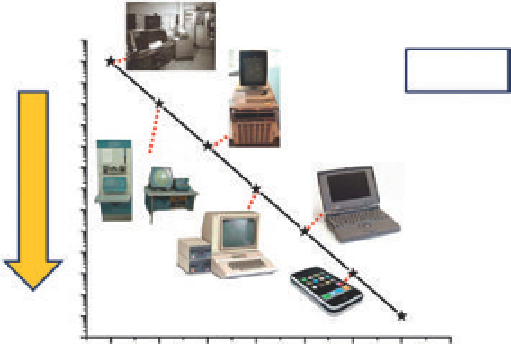Information Technology Reference
In-Depth Information
B.8.20. Fran Allen grew up on a farm in New York State and obtained an MSc degree in mathematics
from the University of Michigan. She joined IBM in 1957 initially to earn enough money to pay off her
school loans and stayed at IBM for the next forty-five years. Her first assignment was to teach IBM
research scientists about the new FORTRAN language that had been developed by John Backus. This set
her interest to compilers and she collaborated with John Cocke on the interaction of computer
architecture and compilers in both the IBM Stretch and ACS projects. In 2006, Allen became the first
woman to receive the Turing Award for her “pioneering contributions to the theory and practice of
optimizing compiler techniques that laid the foundation for modern optimizing compilers and
automatic parallel execution.”
F7
We left that building utterly convinced that designing processors was
simple.”
47
They came back to Cambridge thinking: “Well, if they can
design a microprocessor, so can we.”
48
Eighteen months later in April
1985, they had a working ARM chip.
ARM is different from other microprocessor companies such as
Intel and AMD in that it licenses its technology to other companies
rather than having its own manufacturing facilities. The strategy has
been spectacularly successful. ARM technology is now used in 95 per-
cent of smart phones and 80 percent of digital cameras and, by 2012,
more than forty billion ARM-based chips had been shipped.
Fig. 8.26. The BBC Microcomputer.
The British Broadcasting Company's
Computer Literacy Project in the early
1980s hoped “to introduce interested
adults to the world of computers.”
F6
Acorn produced this popular computer
in 1981 so viewers at home could emu-
late what they saw demonstrated on
The
Computer Programme
TV series.
Bell's law for the birth and death of computer classes
In 1972, Gordon Bell observed that, with Moore's law predicting
that the number of transistors would double every eighteen months,
and with the introduction of Intel's 4004 microprocessor in 1971, it
was possible to predict the broad outlines of the next
forty years of computer evolution. He suggested that
there would be two evolutionary paths for comput-
ers: (1) evolution at constant price with increasing
performance; and (2) evolution at constant perfor-
mance but with decreasing cost. Bell's law states that,
roughly every decade, a new, lower-priced computer
class forms based on a new programming platform
that results in new usage patterns and the estab-
lishment of a new industry. Examples of such new
classes are the emergence of the minicomputer, the
personal computer, and the smart phone (
Fig. 8.27
).
Mainframe
10T
1T
100x smaller
every decade
Workstation
100G
10G
[Nakagawa08]
1G
100M
Laptop
10M
1M
100k
10k
Mini
computer
1k
100
Personal
computer
10
1
Smart phone
100m
1950
1960
1970
1980
1990
2000
2010
2020
Fig. 8.27. A pictorial explanation of Bell's law.




Search WWH ::

Custom Search